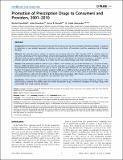| dc.contributor.author | Kornfield, Rachel | |
| dc.contributor.author | Donohue, Julie M. | |
| dc.contributor.author | Berndt, Ernst R. | |
| dc.contributor.author | Alexander, G. Caleb | |
| dc.date.accessioned | 2013-04-17T20:10:48Z | |
| dc.date.available | 2013-04-17T20:10:48Z | |
| dc.date.issued | 2013-03 | |
| dc.date.submitted | 2012-10 | |
| dc.identifier.issn | 1932-6203 | |
| dc.identifier.uri | http://hdl.handle.net/1721.1/78572 | |
| dc.description.abstract | Background: Pharmaceutical firms heavily promote their products and may have changed marketing strategies in response to reductions in new product approvals, restrictions on some forms of promotion, and the expanding role of biologic therapies.
Methods: We used descriptive analyses of annual cross-sectional data from 2001 through 2010 to examine direct-to-consumer advertising (DTCA) (Kantar Media) and provider-targeted promotion (IMS Health and SDI), including: (1) inflation-adjusted total promotion spending ($ and percent of sales); (2) distribution by channel (consumer v. provider); and (3) provider specialty both for the industry as a whole and for top-selling biologic and small molecule therapies.
Results: Total promotion peaked in 2004 at US$36.1 billion (13.4% of sales). By 2010 it had declined to $27.7B (9.0% of sales). Between 2006 and 2010, similar declines were seen for promotion to providers and DTCA (both by 25%). DTCA’s share of total promotion increased from 12% in 2002 to 18% in 2006, but then declined to 16% and remains highly concentrated. Number of products promoted to providers peaked in 2004 at over 3000, and then declined 20% by 2010. In contrast to top-selling small molecule therapies having an average of $370 million (8.8% of sales) spent on promotion, top biologics were promoted less, with only $33 million (1.4% of sales) spent per product. Little change occurred in the composition of promotion between primary care physicians and specialists from 2001–2010. Conclusions: These findings suggest that pharmaceutical companies have reduced promotion following changes in the pharmaceutical pipeline and patent expiry for several blockbuster drugs. Promotional strategies for biologic drugs differ substantially from small molecule therapies. | en_US |
| dc.language.iso | en_US | |
| dc.publisher | Public Library of Science | en_US |
| dc.relation.isversionof | http://dx.doi.org/10.1371/journal.pone.0055504 | en_US |
| dc.rights | Creative Commons Attribution | en_US |
| dc.rights.uri | http://creativecommons.org/licenses/by/2.5/ | en_US |
| dc.source | PLoS | en_US |
| dc.title | Promotion of Prescription Drugs to Consumers and Providers, 2001–2010 | en_US |
| dc.type | Article | en_US |
| dc.identifier.citation | Kornfield, Rachel et al. “Promotion of Prescription Drugs to Consumers and Providers, 2001–2010.” Ed. Alberico Catapano. PLoS ONE 8.3 (2013): e55504. | en_US |
| dc.contributor.department | Sloan School of Management | en_US |
| dc.contributor.mitauthor | Berndt, Ernst R. | |
| dc.relation.journal | PLoS ONE | en_US |
| dc.eprint.version | Final published version | en_US |
| dc.type.uri | http://purl.org/eprint/type/JournalArticle | en_US |
| eprint.status | http://purl.org/eprint/status/PeerReviewed | en_US |
| dspace.orderedauthors | Kornfield, Rachel; Donohue, Julie; Berndt, Ernst R.; Alexander, G. Caleb | en |
| dc.identifier.orcid | https://orcid.org/0000-0002-6388-0768 | |
| mit.license | PUBLISHER_CC | en_US |
| mit.metadata.status | Complete | |
